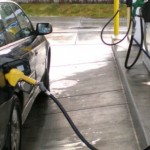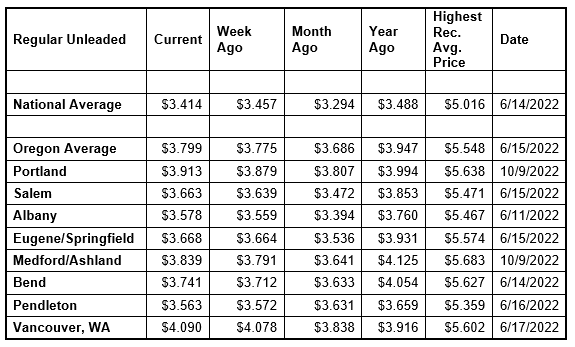
Pump prices are ticking up in Oregon and other West Coast states due in part to a fuel pipeline leak in California. The national average continues to move lower, helped by a dip in demand for gas in the U.S. For the week, the national average for regular unleaded slips four cents to $3.41. The Oregon average adds two cents to $3.80.

A leak was discovered last Thursday at a pumping station in Long Beach, California that provides fuel to Las Vegas. Kinder Morgan Energy Partners, which operates the pipeline, said the pipeline was shut down but then resumed normal operations over the weekend. The situation generated panic buying by consumers who waited in long lines to fill up their vehicles. The outage put slight upward pressure on prices along the West Coast.
Crude oil is trading around $79 today compared to $77 a week ago. In January, West Texas Intermediate ranged between about $73 and $82 bbl. and was $95 a year ago. Crude reached recent highs of $123.70 on March 8, 2022, and $122.11 per barrel on June 8, 2022. The all-time high for WTI crude oil is $147.27 in July 2008.
Crude prices tend to increase when geo-political events have the potential to disrupt supply. Crude prices rose dramatically leading up to and in the first few months of Russia’s invasion of Ukraine. Russia is one of the world’s top oil producers and its involvement in a war causes market volatility, and sanctions imposed on Russia by the U.S. and other western nations resulted in tighter global oil supplies. Oil supplies were already tight around the world as demand for oil increased as pandemic restrictions eased.
Crude oil is the main ingredient in gasoline and diesel, so pump prices are impacted by crude prices on the global markets. On average, about 56% of what we pay for in a gallon of gasoline is for the price of crude oil, 20% is refining, 11% distribution and marketing, and 14% are taxes, according to the U.S. Energy Information Administration.
Demand for gasoline in the U.S. dipped slightly from 8.49 million to 8.43 million b/d for the week ending February 3. The current gas demand rate is approximately 700,000 b/d lower than the rate during the first week of February 2022. Meanwhile, total domestic gasoline stocks increased significantly by 5 million bbl to 239.6 million bbl last week. Lower gas demand and growing total domestic stocks should put downward pressure on pump prices, barring other market forces.
Quick stats
Oregon is one of eight states with a week-over-week increase. Nevada (+10 cents) has the largest jump, due to the pipeline outage that impacted Las Vegas. Maryland (-14 cents) and Delaware (-14 cents) have the largest weekly drops.
Hawaii ($4.89) is the state with the most expensive gas in the nation for the 12th week in a row. California ($4.65) is second, Nevada ($4.15) is third, Washington ($4.14) is fourth, and Colorado ($4.03) is fifth. These are the only five states with averages at or above $4 a gallon. This week 44 states and the District of Columbia have averages in the $3-range. Texas ($2.995) is the only state with an average below $3 a gallon.
The cheapest gas in the nation is in Texas ($2.995) and Mississippi ($3.05). For the 109th week in a row, no state has an average below $2 a gallon.
The difference between the most expensive and least expensive states is $1.90 this week compared to $1.85 last week.
Oregon is one of 46 states and the District of Columbia with higher prices now than a month ago. The national average is 12 cents more and the Oregon average is 11 cents more than a month ago. Colorado (+73 cents) and Utah (+46 cents) have the largest monthly gains. Indiana (-20 cents) and Hawaii (-11 cents) have the largest monthly declines.
Oregon is one of 38 states and the District of Columbia with lower prices now than a year ago. The national average is seven cents more and the Oregon average is 15 cents less than a year ago. Colorado (+69 cents) has the largest yearly jump. Delaware (-35 cents) has the biggest year-over-year decline.
West Coast
The West Coast region continues to have the most expensive pump prices in the nation with six of the seven states in the top 10. This is typical for the West Coast as this region tends to consistently have fairly tight supplies, consuming about as much gasoline as is produced. In addition, this region is located relatively far from parts of the country where oil drilling, production and refining occurs, so transportation costs are higher. And environmental programs in this region add to the cost of production, storage and distribution.















